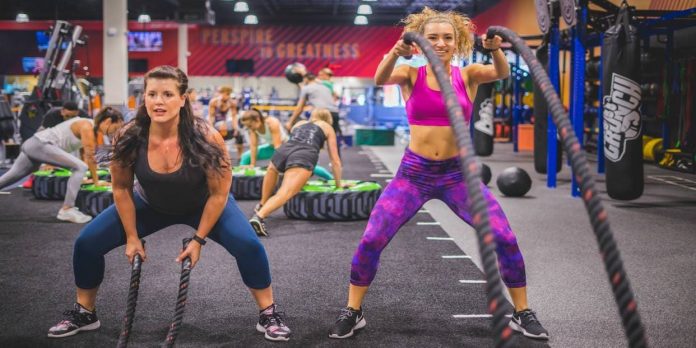Whether you’re looking to maintain a consistent workout routine, improve your endurance, or build muscle, there’s a goal for everyone on this list—no matter their fitness level.
With the first month of 2022 behind us, many may be losing steam when it comes to sticking to their New Year’s resolutions. Why? Because people either set unrealistic goals that leave them discouraged or fail to hold themselves accountable through tracking their progress, Lindsay Ogden, a NASM-certified personal trainer at the health club chain Life Time, tells Health.
Therefore, the key to setting yourself up for fitness goal success is devising them with the SMART method in mind. This tried-and-true approach creates goals that are:
Specific: The goal is clear and defined. For example, “workout three times a week” rather than “exercise more.”
Measurable: There’s a way to track your progress, which could be logging the weights you lift or the distance you run each week.
Attainable: This goal can be feasibly reached within the set time frame. Very few people could train for a marathon in two weeks, but many could over a couple of months.
There’s a “why” driving your motivation to reach the goal. Maybe you want to feel stronger, more flexible, or manage an underlying condition.
Timely: The goal has a deadline whether it’s four weeks or six months.
Ogden also recommends adding an “E” for emotion: in other words, what will it feel like to achieve the goal? Will you feel more confident? Empowered? “Emotion will make it more real,” she says.
If you already have a specific goal in mind, that’s great. If not, here are 10 fitness goals devised by personal trainers you may want to tackle.
1. Work out 12 days in one month
Consistency is key for building exercise habits and seeing results, but staying motivated can be tough, especially if you’ve been inactive for a while, Mike Donavanik, an NSCA-certified strength and conditioning specialist and founder of the fitness app Sweat Factor tells Health. This is why he recommends setting a smaller goal that you know you can stick to, like three workouts a week.
You can achieve this by scheduling your sweat sessions in advance—bust out your planner and mark at least 12 days next month that you know you’ll have the time to exercise. Then, set phone reminders on those days so you can remember to pack gym clothes or shoes if need be.
For some added accountability, share your goal with a friend, or better yet, start a challenge to see who can plow through those 12 workouts sooner. Once the first month is up, Donavanik says you can reassess and adjust your goal: maybe next month you aim for 16 workouts.
2. Run continuously for 1 mile in 6 weeks
This goal is great for someone who hasn’t exercised in a while and is looking to improve their cardiovascular health, Hannah Clausen, NASM-CPT, director of coaching for Macros Inc tells Health. Building cardiovascular endurance improves bone, heart, and immune health while reducing the risk of heart disease and type 2 diabetes.
While one mile may seem daunting, Clausen suggests focusing initially on shorter distances at first—like ¼ or ½ mile. Then, gradually increase the distance each week by ⅛ mile and track your progress by writing down how long you were able to run without stopping.
Rather than worrying about speed, Clausen advises you to maintain an easy, steady pace. But when you need that little extra push, use mental mini-goals like committing to running one more block, or until the song you’re listening to ends.
3. Try a new workout a week till you find one you like
Since the best exercise is the one you can stick to, try different workouts every month until you find what you enjoy. Plus, varying your workouts will challenge your body, work new muscles, and build different skills, so you’re more likely to see results, Elizabeth Treese, a NASM-certified Personal Training Manager at Life Time tells Health.
To achieve this goal, create a list of different workouts you would like to try, whether it’s yoga, running, kickboxing, or even rebounding (aka trampolining). Then, look into class schedules at local gyms or fitness boutiques, and schedule ahead of time. As a bonus, many will offer new student or first-class specials. If you would rather stay at home or in the neighborhood, you can also find a local running group or a free trial for an online fitness app.
4. Average 10,000 steps a day for a month
Unlike other cardiovascular exercises such as running, walking is easier on the joints. Plus, keeping a brisk pace ensures you reap similar health benefits like reduced stress and better immune function. However, achieving a strict 10,000 steps a day may seem daunting. Therefore, try focusing on an average for the month so you can ease some of the pressure because let’s be honest: some days it’s okay to just sit on your couch.
Since daily steps vary from day to day, Clausen recommends scheduling longer walks ahead of time, say, on weekends, or when you know you have a lighter workload. You might also want to keep a pair of sneakers in your work bag, car, or under your desk. That way, you’re always prepared to squeeze in lunch break strolls. Then, record your daily step totals in a fitness journal or app.
5. Do X number of push-ups in 4-6 weeks
You’ll be hard-pressed to find a better exercise for increasing your upper body strength than push-ups, according to Becky Miner, NASM-CPT, a nutrition coach for Macros Inc. That’s because this simple, classic move engages muscles in your chest, shoulders, abs, and arms all at once. Plus, they require no special equipment and can be done anytime, any place. Therefore, try setting a goal for how many you want to be able to complete after a month or so whether that’s one no-knee push-up or 10.
If traditional push-ups on your toes are too challenging, Clausen says there are a few beginner variations you can try:
Incline push-ups against a stable counter, bench, or chair. The more parallel to the floor you are, the harder this variation will be.
Knee push-ups: This is just like a regular push-up but your knees are on the floor at a 45-degree angle.
Combo push-ups: If knee push-ups are a bit too easy, but you still can’t do a traditional one, try starting in the classic position. Then, (slowly) lower yourself all the way to the floor and push back up with your knees on the mat.
Start with whatever modification you can do 10 reps of three sets of, says Treese. Once you increase your rep count to 15, switch to a more challenging version.
6. Rest for eight full days a month
Once you’re determined to reach a fitness goal, it can be easy to want to push your body every day. However, rest days are crucial not only because we all need a good Netflix binge, but also because your muscles do, too! These breaks are actually when muscles repair themselves so they can become stronger, Kollins Ezekh, a NASM-certified personal trainer and owner of Mayweather Boxing + Fitness in Los Angeles says.
How many rest days you need depends on you and your training, but as a general rule, Clausen advises allotting two days off a week. If you’re new to an activity (or new to working out in general) you may need even more.
“Listen to your body,” says Chris Musser, a certified personal trainer at Crunch West Hollywood. “When you’re feeling really exhausted or sore after a workout, then plan an extra rest day. Exercise tends to release cortisol, a stress hormone, and if you already have a lot of cortisol from other life stressors, you could be wearing your body down even more.”
And, if you feel good, you can still incorporate light movement into your rest days like taking a walk or doing some gentle yoga, Treese says.
7. Stretch for 15 minutes after each workout
While stretching may not torch calories or give you six-pack abs, it’s still a crucial component of fitness. In fact, according to the National Academy of Sports Medicine, stretching increases flexibility improves range of motion, and reduces inflammation—all of which help stave off injury.
The ideal time to lengthen those ligaments and tendons is after a workout when your body is already loosened and warmed up, Musser says. Plus, “Stretching offers a nice transition for your body and mind from a workout state back to a resting state,” he adds.
You should spend about 25% of your workout recovering, according to Ezekh. So if you’ve allotted one hour for exercise, spend the last 15 minutes stretching. He recommends stretching muscles you specifically worked that day and holding each stretch for 15 to 45 seconds.
8. Hold a 1-minute plank in 30 days
Planks are a great full-body exercise that work muscles in your chest, arms, legs, and most famously, your core (aka your abdominal and back muscles). The importance of a strong core goes beyond aesthetics: it maintains proper posture which reduces back pain and other injuries.
While planks may be stationary, that doesn’t mean they aren’t hard. To work your way up to your one-minute goal, hold a plank two to three times a week. Start with 20 to 30 seconds and then up the duration by 5-second increments, Ezekh says. You can also begin on your knees and work your way up to a plank on your toes.
9. Drink 2-3 liters of water daily for a month
Drinking enough water is crucial for preventing dehydration, which can hinder your workout by causing fatigue, dizziness, and even fainting, according to the National Library of Medicine. That’s why it’s important to drink plenty of water throughout the day, so you’re already hydrated by the time you start sweating out, says the Centers for Disease Control and Prevention (CDC).
How much water a person should drink daily will vary depending on their activity level, diet, body weight, and even the climate of where they live. In general, though, men should aim to consume 3.7 liters (or 15.5 cups) of water and women should aim for 2.7 liters (or 11.5 cups), per the US National Academies of Sciences, Engineering, and Medicine’s guidelines. However, those recommendations also include fluids you take in from foods, which is why you don’t have to meet them through water intake alone.
To make sure you’re drinking enough H20, buy a big reusable water bottle you can carry with you and fill it up throughout the day. You may even want to make a goal to finish one liter by a certain time so you’re not guzzling it all right before bed.
10. Complete a 5K race in 3 months
While running a 5k is a more advanced fitness goal, it’s perfect for someone who may feel more motivated with a race day marked in their calendars. It’s also great for those who have always wanted to run a half marathon or marathon, but need to work up their endurance and stamina, Clausen says.
The key is to give yourself enough time to train: find a race that’s at least 12 weeks out and aim to run three times a week, Clausen says. If you can, recruit a running buddy, who can lend a sense of accountability — not to mention, make the experience more social and fun.
Most important of all? Be kind to yourself
If you’re struggling to meet a fitness goal, it’s okay. Instead of beating yourself up, thank your body for all it has helped you accomplish. Then, reassess whether your current goals are realistic for you right now or if they need to be adjusted.
“Give yourself a ‘clean slate policy’,” says Treece. “Forgive yourself for the past, and look at today as a new opportunity to get back on track.”
This also might be a good time to remind yourself of your “why” that motivated you to tackle this goal in the first place.
“Change isn’t easy,” Musser says. “But when you are able to pull yourself out of your comfort zone, you’ve done some truly remarkable work.”





















